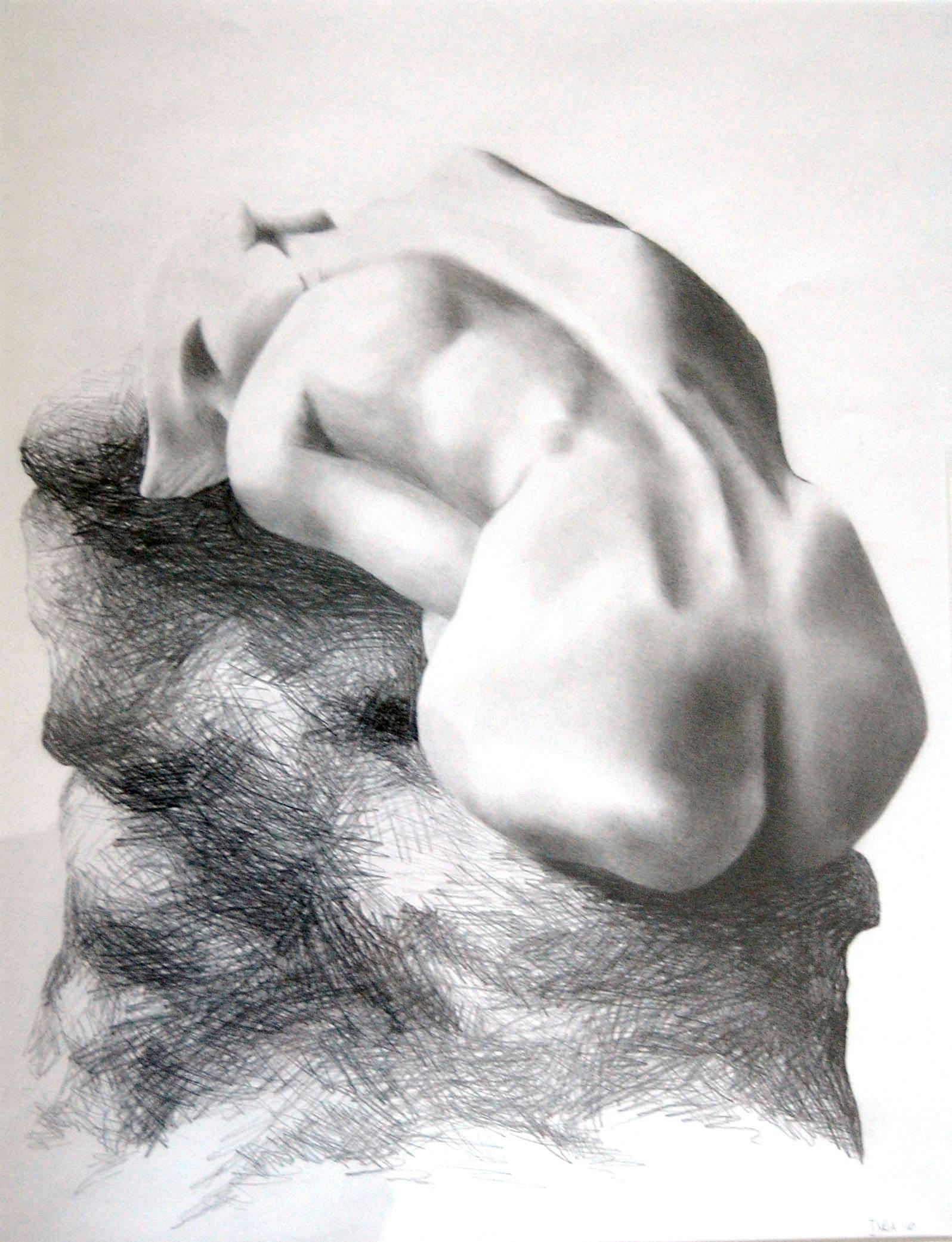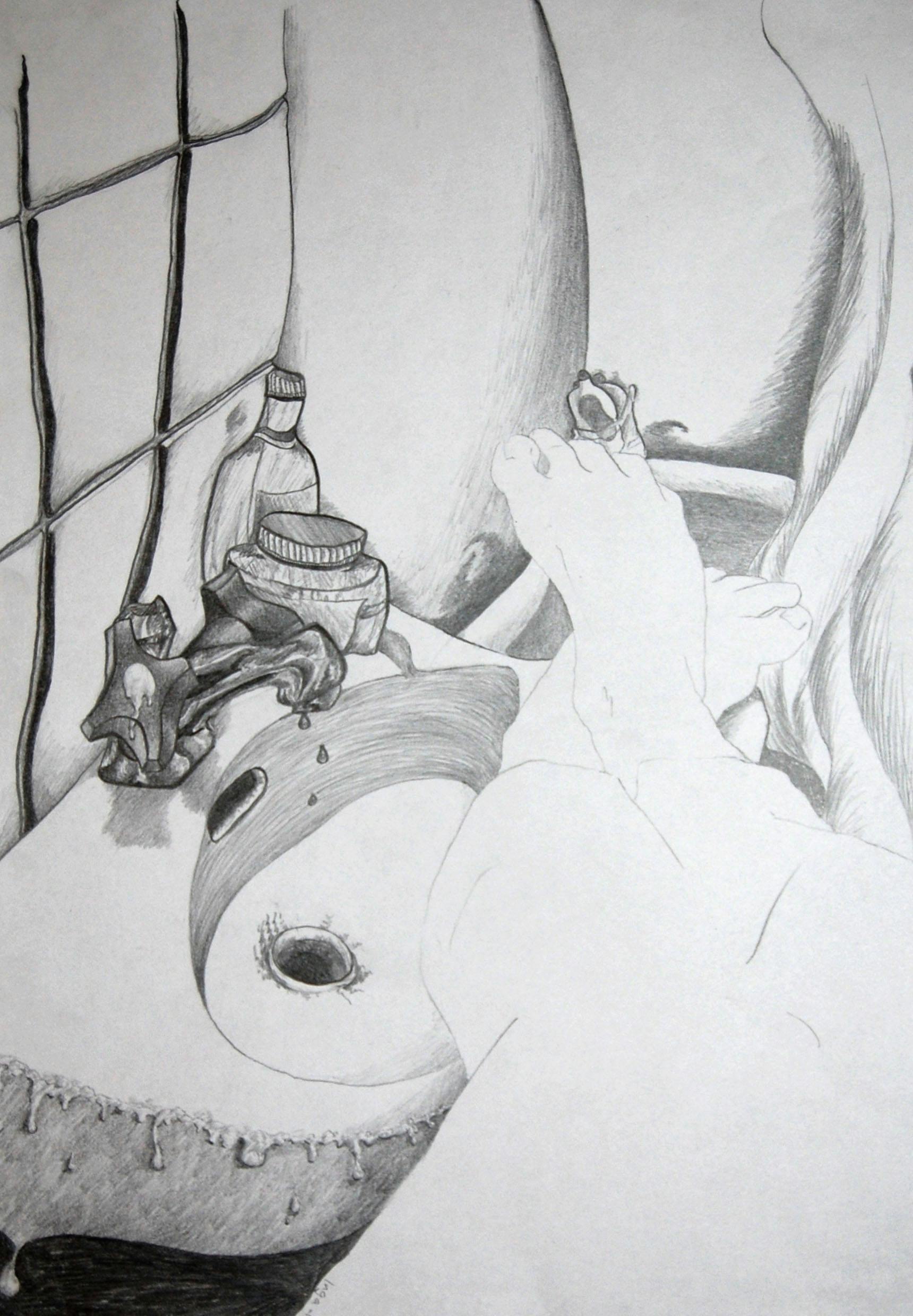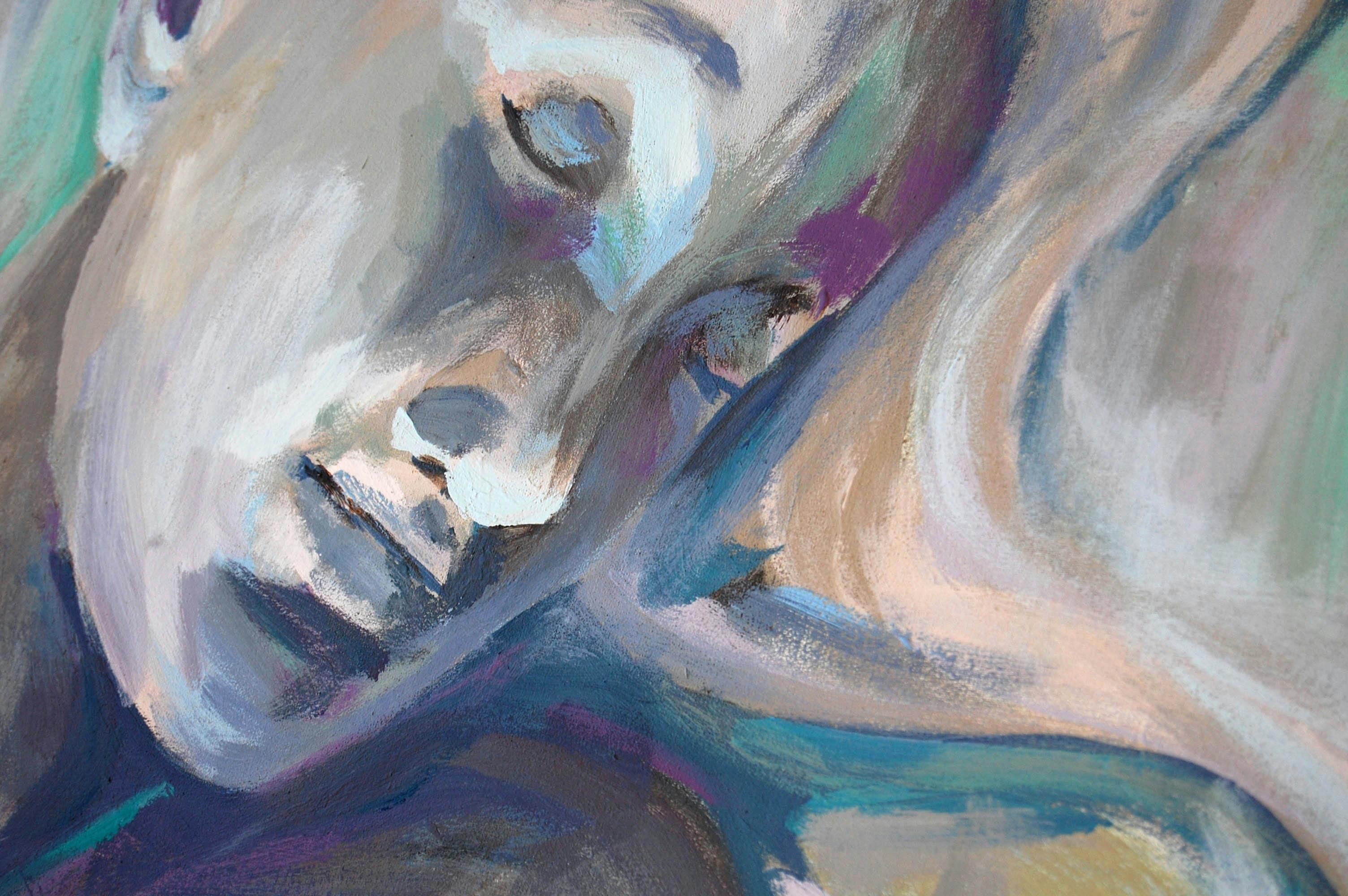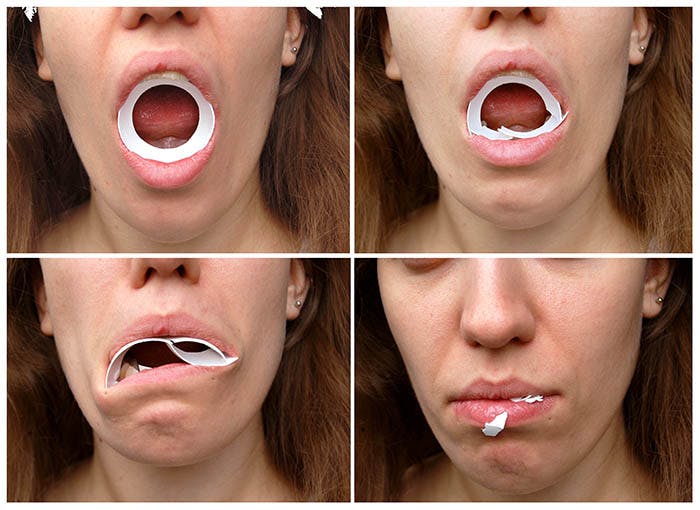Getting accepted into art school
(This text is about my experience when applying to art schools, and may not be relevant to art school application processes outside of Sweden.)
The first time I applied to an art school was in 2011, ten years ago as I'm writing this. It was the year I graduated from upper secondary school, full of anxiety and with no idea about anything, other than that I wanted to make art. Prior to the application I went through the internet, trying to find people sharing their letters of application and portfolios, because I had no clue of how to present myself as an artist, neither through image nor text. The results were sparse – to upload your application doesn't seem to be something one does too willingly, and I can see why. It's a vulnerable process. Here, I'd like to do the opposite: I've had the priviledge to get accepted into four art schools, and I want to show how. The portfolios and personal letters that I've kept are all here. It definetly feels cringy, to look back and read the old texts, but if it may be of help to someone in the process of applying to an art school, then it's all worth it. In the end I've gathered a bunch of advice, mostly stuff that I wish that someone had told me and stuff that I've learned since. This text is not about how to put together a strong portfolio – that stuff I don't know about – but rather ways of thinking that I've found helpful in my process. You're welcome to read this whole text in order along with the intervowen portfolios, or jump directly to the end and my advice.
The four art schools that I've applied to are:
Nyckelviksskolan in Stockholm, 2011
Konstfack in Stockholm, 2014 and 2017, and
Estonian Academy of Arts in Tallinn, 2016.
Nyckelviksskolan is a one year preparatory art education with several artistic tracks. I applied there after my graduation, got accepted into the Ceramics course and landed a 4th reserve spot on the general track losely translated as Colour, Form and Craft. I was more interested in the latter, so when a spot opened up I chose it instead of the ceramics course.

I can't find my motivational letter to this course, which I guess is lucky. The portfolio I submitted can be found here. At that time, I seem to have been depicting mostly naked female bodies, which is not wrong in and of itself, but I wish my interests would've been more ...broad. The images were to be mounted on cardboard and physically submitted, so I took the train down to Stockholm to do so in person. The school asked for three paintings and five drawings, and it was also painting that I wished to develop at the time. One of the drawings was to be an assignment on the theme ”bathroom”. I found it fun to try out the different craft methods that the school offered, but they were not the main reason I applied. In hindsight I feel that I should have chosen a school that was more focused on technical painting – Nyckelviksskolan had a focus on personal expression, which left me frustrated when I wanted more feed back on my technical development, and in the end I was dissatisfied with my whole experience there.
Lessons learned: an art education is not the solution to one's problems; research the education before applying and make appropriate demands on the education. I don't think I did any of this in this application.

Konstfack is one of the more prominent art schools in Sweden, and I've been applying there more times that I've been accepted, which is fair. In 2014 I applied to the teacher education towards upper secondary classes in the subjects of Art and Media. The same year I also applied to the Fine Art programme, which I'd also done after my year at Nyckelviksskolan. I didn't make it in this time either, but I was accepted to the teacher education and I remember being very happy about that.
The application consisted of three assignments: ”Meeting the world and its images” was to be a series of five images. The second assignment was to re-make something from your kitchen, and the third assignment was a freely formulated idea of one's own. Here is the whole thing.
Lessons learned: To be honest in your application, to do the research about the school and to make approriate demands. This time I think I did all of this when applying to the teacher education, but in my application the Fine Arts programme, the portfolio seems fragmented and confused, and my expectations on the education seem vague. Applying to the teacher education was more of the opposite – when I applied I thought of the teachers that had inspired me and I really felt that being an art teached was something I wanted to do after the education. This time I also asked for help before sending in my application, reaching out to some of the teachers I'd had for feedback on my portfolio.

In 2016 I got the opportunity to do an exchange as part of the teacher education, and I applied to Estonian Academy of Arts, or EKA, in Tallinn. There I applied to the painting department and even though it was an exchange it still meant the same process of composing a portfolio and writing a personal motivation letter. I can not remember there having been a maximum number of images, which is probably why I submitted so many. At this point I felt that I had more of an artistic field of interest and also more of a personal way of expression, even though I was still searching in many ways. My portfolio really incuded everything, both more technical images such as my portraits and more creative pictures, such as atmospheric paintings from parties, pictures of jewellery I had just started making and photography. In my letter I underline how I'm inspired by peoples' weirdness while I also see that same weirdness as a life force within every individual, something I find very beautiful. Reading this I get the impression that at this point, I had become more and more aware of who I was as an artit and what I was searching for.
Lessons learned: I finally had the courage to show in an application myself and my goals as an artist, and I think one can tell. I would definetely have been sad, had I been rejected, but I gambled and expressed myself in a more bold and unconventional manner, and I think that this is what paid off in the end.

After my exchange I felt inspired to once again pursue a more artistic education. I had also found an interest in a more body-based kind of art, both using materials relating to the body but also making objets worn on bodies and interactive artworks. I decided then to apply to Ädellab at Konstfack, an education focusing on jewellery but which also prioritized experimenting with materials and methods. This was in spring of 2017. I think that I, at the same time, once again applied to Fine Arts but with no success. Just as well. The application to Ädellab required solving an assignment which was to create three tools, submitting a portfolio and a CV. The tools I submitted were more of a poetic and symbolic nature than a practical one and my portfolio still contained a lot of paintings, even though more and more jewellery pieces, material experiments and extensive art projects made in Tallinn had now started to take place there. My CV was nothing much to brag about, but I submitted it anyway. I made it to the interviews: it was both a group interview where we had to solve an assignment together while also being called to individual interviews in intervals. I had the advantage of already having spent three years at Konstfack, which definetely made me feel more secure in the circumstances, even though I hadn't met any of the teachers before. After the interview I didn't hear back for a long time, and I had already accepted that a rejection was coming. Then one day I opened my inbox and there it was: I had been accepted.
Lessons learned: To have plenty of time to compose the portfolio and to feel safe during the interview makes a world of difference. I remember thinking that it would be OK if I got rejected, because even though I wanted to attend this education, I'd be happy with finishing my teacher education where I still had two years to go. I think that this sense of security contributed to me daring to be bold, both in my application and the interview, to me daring to be 100% myself, because I thought that ”if they don't want this, so be it.” I felt like I really had nothing to lose, and that was very liberating.

And now to my advice. Here are some things that I would really want to recommend for anyone applying to art school to consider. This is stuff that has worked for me in all my years of applying, both when accepted and rejected. This is also stuff that I wish that someone had told me ten years ago when I started applying. Note that I have never been part of a jury, so I actually have no idea about what goes on on that side of the process, and that this is advace based on what has worked for me, but that doesn't have to work for everyone. Take it as it is, with a pinch of salt or not at all.
Make sure to have plenty of time
This the first advice always given on this topic, and it can't be stressed enough how important this is. Make sure you give yourself plenty of time so that you can give your work plenty of love. Is the deadline in April? Start in October. Stress will lead to lower quality in portfolios, worse self-esteem and a harder hit should the rejection arrive. Give yourself time to put your heart in the work – even if you get a rejection, you will still know that you did all you could.
Follow the instructions
This may seem obvious, but so many applications are discarded if they're incomplete. Carefully read what the school asks of you, make sure you have all the correct merits and send in everything according to formalia, no more and no less. If the instruction states that the application should contain maximum 1000 words, don't send in an application with 1001 words. An image of maximum 12mB should not be 12,5mB, and so on. Follow. The. Instructions.
Ask for help
Don't be afraid of more viewers, more readers and more critique on your application. It's so easy to get stuck in your own application-bubble, but in this case a greater number of cooks really can make for a better soup. If you have friend who's great at photography, ask them to take photos for your portfolio if photography is not your strong side. Then you can put more effort in the stuff that you're really good at. Also ask your friends and family to read your application, and I mean really do this. Tell them what you want to say with the application, ask them if they think that is clear in the writing and ask for feed back to sharpen everything that can be shaprened. Especially texts often require several readers and several turns of processing to get really good, so be humble to critisism and don't be afraid. Your application will be viewed and read by an unknown jury, and you should be more afraid of their opinion than what your friends will think of you.
Consider the future
Ask yourself: where do I see myself after the education? Truth is, I've never planned ahead, which has made every graduation a shock of confusion and dislocation. And that's OK, but it can also be helpful knowing in advance that you don't know. Or on the other hand, to set a very clear goal already before the education, such as getting into the next art school or to get a specific job. In that way, one can focus on the goal already during the education; if the goal of a preparatory art school is to get into an art university, then the assignments there can become an artist portfolio later on. If the goal is to work within an artistic field, then the focus can be to make contacts and have many collaborations during the education. If the goal is to have fun, then one can really see it as a personal, creative progress and not get dragged along in classmates' application stress, and so on. You don't have to know your future, but consider it.
Make demands
This is something I wish someone had told me prior to all of my applications, and this is actually my most important advice. Ask yourself: why do I want to attend an artistic education? What are the benefits of studying at an art school, versus making art on your own spare time? Got the answer? Good. Next question: which is the best art school for me to get what I want? Research different schools, look at graduation works, publications and exhibitions. Even if the works are made by individual students, one can often spot a common theme; one can see the conditions that the school gives its students. Are there any materials, designs or methods that seem to re-occur? Do many students use the same type of language when describing their work? Or do many students choose to investigate the same type of concepts? That is the impression of the school. Be aware of this, and carefully consider what you think of it. Don't be afraid to make high demands here – ask yourself: what can the art school do for me?
Often, we try to satisfy a jury group and show them how good we are, but it has to go the other way as well, with the school answering to the students' demands and needs. If you get the chance to attend an Open House or to meet former or current students, do it! And ask questions, ask all the questions and ask critical questions. No school is perfect, and a good CV-merit isn't worth years of being disappointed.
Show yourself
No one else can make the art that you make, because no one else is you. Most art schools today are looking for individual expressions and creativity. It can be tempting to show off a good skillset, but in the end it's about expressing yourself. The same goes for the motivational letter: don't think about what you think that the school wants to hear, but focus on making it as clear as possible who you are as an artist and why you want to attend the school you're applying to. If you've done your research and if you honestly want to attend this school because you know what it can do for you, then it will show in the letter, even if you don't use advanced or academic language. And another thing about language: rather be simle and clear than formal and vague. Get to the core of your intentions, and do this even if you're not exactly sure about your intentions. It's OK not to know, to search and to fumble, but be open about that that's where you're at right now.
The judgement is not personal
And this is the absolutely most tricky part about applying to an art school, compared to applying to most other educations: to remember that the judgement made by the school isn't personal. Despite the fact that the portfolio submitted and the art shown is personal. But to remember this can both soften the disappointment of a rejection as well as lower the hubris from an admission. Remember that the jury group not only looks at individual applications, but that they're also putting together a group or class for the coming year, and most probably take into account things such as balance and group dynamics. Remember that you're competing with sometimes hundreds of others for the same spot, and here it's essential that you know why you want to attend the education and that you express that clearly. Here it's essential that your application is correctly formulated and formatted and there is nothing personal about these details, really. Remember that. Don't let a rejection from an art school be a reason for you to quit on art. And equally, don't let an admission get to your head – an art school might give you advantages, but you still need to work hard if you want to develop in or live off your art.
Art school does not automatically make you into a successful artist
Here is my last advice, and here I'd really like to open up to the question: why even attend an art school? What does it lead to? There are many amazing artists and craftsmen who've never set their foot in an art school and still can support themselves with the art they're making, or at least spend time doing what they love. There are also many artists who have attended countless art educations and still can't make it work. What makes an artist? In the end, it's what you make of it that determines the result. To make art and to make a living off of art is about putting a lot of time, effort and focus into something, to be driven and to continue onwards despite rejections raining down on you. An art school can simplify things, but in the end it falls on yourself to make it work.
After the year at Nyckelviksskolan I had very low self-esteem as an artist. I felt that the things I was making weren't appreciated by anyone, and I didn't dare to apply to any art schools until three years later. A big reason was also the mental illness I had to work on at the time, but having spent a year at an expensive education that didn't meet my expectations – I wanted to work more technically than creativey – and right after that be rejected from Konstfack became proof to me that I wasn't any good. It's not until in hindsight that I've realized that I could have made more research in advance, applied to differnt schools, asked for help and feed back and taken rejections as well as admissions less personally. But, this takes time and experience, which I also hadn't gained had I done it any other way.

Today I'm still searching for a balance between art as a meaningful outlet and art as a way to support myself, and it will probably take another ten years before I've learned all my lessons. It will be difficul and confusing, and I look forward to it very much.